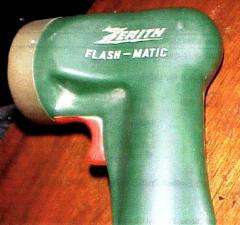TV remotes to undergo big change

In 1955, Zenith introduced the first wireless TV remote control, the Flash-Matic, followed a year later by the Space Command.
Since then, the standard remotes that most viewers get with their TVs or when they sign up for cable have changed little, adding buttons but retaining the same basic design and button format in an effort to keep costs low.
But as technology improves and gets less expensive -- and the remote manages a wider range of content -- it's finally ready for a makeover.
Several companies are working on major upgrades to the remote as the number of viewing options grows and Internet content migrates from the PC to the TV.
Everything from touchpads to voice control will soon come to your humble remote.
Expensive, high-end remote controls have been around for years from independent companies such as Logitech. But when it comes to the low-cost remotes bundled with a TV or provided by a cable or satellite service, the basic layout would be recognizable to any time-traveling couch potato from 1956.
Juergen Schroter, an executive director with AT&T Labs, said current remotes aren't going to cut it for much longer.
"The options for the typical viewer are exploding," he said.
Schroter said that the conventional response to this growing array of options would be to just keep adding buttons.
"That leads to a very heavy hammerlike device with lots of keys," he said. "We believe here in the labs that speech will basically make it possible to leapfrog all this and just tell the system what you want to watch."
So rather than adding buttons to the remote, AT&T's solution is to take buttons away.
"The nice thing about the voice capability is that it's one switch," said Mazin Gilbert, also an executive director in AT&T Labs.
"It's something that even a 1-year-old can understand. You press (a button) and say what you want."
AT&T's prototype of the voice remote that will eventually be available to its U-verse TV subscribers is built around the company's "Watson" speech recognition technology.
"The goal of what we do is not to recognize speech only, but also to understand what the user is saying," Gilbert said.
"If you press the switch and you say, 'Action movies with Harrison Ford,' the goal here is not just to recognize that. The goal here is to understand that action movies are types of movies and Harrison Ford is an actor, or he could be a director, too. That's what the technology we have in place does."
While voice-controlled remote controls are not new, AT&T says its Watson devices will recognize hundreds of thousands of words, compared with a few dozen in competing models.
AT&T already has functioning prototypes of its voice remote, Gilbert said, and consumers will probably be getting them in a few years.
Voice isn't the only upgrade coming to the basic remote.
Dish Network Corp. is releasing its HD DuoDVR SlingLoaded ViP 922 digital video recorder this year.
And bundled with the DVR is a touchpad remote with an underside trigger that does away with the traditional keypad altogether.
EchoStar Corp. developed the DVR and remote for Dish.
Although EchoStar is using different technology than AT&T, it's addressing the same issue.
"The customer doesn't want to have to keep looking down at a 50-button remote control and then look up at the screen," said Gregg Martch, vice president of hardware engineering in the EchoStar Technologies division. "They just want to look at the screen."
Rethinking the remote was particularly crucial on the 922.
In addition to offering a standard DVR and Sling functionality for streaming recorded shows over the Internet, the 922 also has a Web browser.
A standard remote just wasn't going to work with all those options, Martch said.
"We see it as a paradigm for future products," he said of the new remote. "Obviously 922 is our first offering with this kind of technology, and it's a grand experiment."
Martch noted that keeping costs down was a big concern when designing the remote, but some of the cutting-edge technologies reduce overall costs.
For example, the 922's remote has a two-way radio so it can transmit data back and forth with the receiver.
A simple on-screen guide lets users program the remote to control additional devices, such as a DVD player, rather than having to hunt through a paper booklet for that device's code and manually program it in.
And that automation reduces the number of calls to Dish's customer service department, which cuts overall expenses.
Not everyone is convinced that the remote needs a face-lift, though.
Verizon Communications Inc., for example, says it will handle the growing number of viewing options on its FiOS TV service by improving the on-screen menus.
Verizon spokesman Lee Gierczynski said the on-screen keyboard available through the FiOS interactive media guide works fine with current remotes.
"In the future, if a customer wants to find Internet content, they could potentially use our current search function with our current remote control," he said.
"Some cable companies don't have an advanced search function within their media guides to handle searches in this manner.
"So basically, it is not the remotes that will change in the future, but the interface we provide customers."
But Schroter at AT&T said the number and complexity of TV viewing options is growing too fast to be managed by traditional remote controls.
"The technology curve makes our life more and more complicated," he said. "We're trying to simplify that."
___
(c) 2009, The Dallas Morning News.
Visit The Dallas Morning News on the World Wide Web at www.dallasnews.com
Distributed by McClatchy-Tribune Information Services.

















